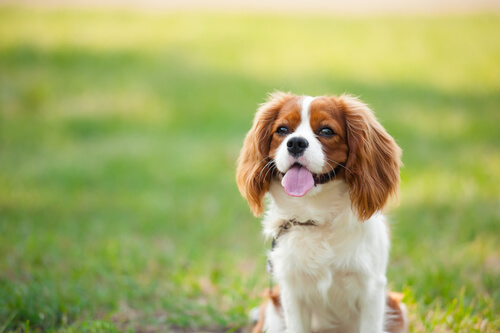| Kingdom | Animalia |
| Phylum | Chordata |
| Class | Mammalia |
| Order | Carnivora |
| Family | Canidae |
| Genus | Canis |
| Species | C. lupus |
| Species | C. lupus familiaris |
| Niche | Domestic |
| Height | 13-18 lbs (5.9-8.2 kg) |
| Weight | 12-13 inches (30-32 cm) |
| Lifespan | 9-14 years |
| Social Structure | Social, domesticated |
| Breed Status | Common |
| Preferred Habitat | Domestic |
| Average Litter Size | 5 puppies |
| Main Food Item | Dog Food |
The Basics
The Cavalier King Charles is a small domestic dog breed. One of the largest breeds in the ‘toy’ category, it is a show dog and therapy dog. It is also a common companion and pet and has long been associated with British Royalty. Cavalier King Charles Spaniels are distinguished from the very similar King Charles Spaniel primarily by their size and longer muzzles.
Appearance
Cavalier King Charles spaniels are small, weighing about 13-18 lbs (5.9-8.2 kg) and standing 12-13 inches (30-32 cm) tall. They have very smooth coats and smooth, undocked tails. The breed has a domed head, large eyes, and long, hanging ears that are typical of most spaniel breeds. King Charles Spaniels and Cavalier King Charles share much of their history. However, King Charles Spaniels were eventually bred with pugs and other short-muzzled dogs, ultimately distinguishing them as separate breeds. Besides having a longer muzzle, the Cavalier King Charles is slightly larger as well.

The Cavalier King Charles has a medium-length coat that is soft and smooth. Adults have wavier fur and often develop feathering on their ears, paws, and tails. Cavaliers occur in four color variants, namely, the Blenheim, which is a rich brown color on white. There is also the ‘tricolor’ Cavalier, which has black markings on a white coat with some tan over its eyes. The ‘black and tan’ variety is similar but has more tan and less white than the ‘tricolor’. Finally, ‘ruby’ Cavaliers are a rich reddish-brown color with no white markings at all. Each of these varieties has its own history. The Blenheim variety, for example, was named by the Duke of Marlborough in honor of his residence, Blenheim Palace.
History
The Cavalier King Charles originated in East Asia and arrived in Europe in the 1500s. They have long been linked with British royalty. Indeed, they received their namesake after King Charles II of Great Britain and Ireland who made the breed popular along with other royal family members over the centuries.
Early versions of the breed were gifted to European royalty by Japanese diplomats. It is thought that they likely share a common ancestor with the Pekingese and Japanese Chin dog. From these dogs that arrived from Asia, several modern breeds were formed including the Cavalier King Charles and the stouter, shorter-nosed King Charles Spaniel.
The breeds that became the modern-day Cavalier King Charles were initially used for hunting but eventually became obsolete in favor of larger breeds. Following the death of King Charles, the popularity of these Spaniels waned and in many places, the breed was altered by cross-breeding with flat-faced breeds. The long-nosed spaniels depicted in paintings from earlier centuries were almost extinct. Following dedicated revival efforts during the last 100 years, the breed was recognized by the Kennel Club in 1945. Eventually, it made its way to America where it was recognized by the American Kennel Club in 1995 and remains highly popular to this day.
As Pets
Cavalier King Charles are popular pets due to their friendly demeanor and relatively small size. This allows them to live in apartments and other small houses. They are good with children and other pets, especially if socialized at a young age. However, like most dogs, they require a significant amount of attention and should not be left alone for long periods. Due to their slight stature, they are not known as effective guard dogs but will bark to alert their masters of others. Females typically give birth to about 5 puppies, and the average lifespan for individuals is 9-14 years.
Fun Facts about Cavalier King Charles!
The Cavalier King Charles Spaniel has a long and regal history and is has long been associated with British royalty. It also remains one of the most popular breeds as pets in the West.
Bred to be Happy
The Cavalier King Charles is a well-tempered dog and is often observed to almost always be wagging its tail. In fact, this is no accident. As a common show dog, breeders pay careful attention to the traits of the breed. Indeed, one trait that is commonly selected for is a tail that is almost constantly in motion while the dog is also moving.
The Royal Decree
The Cavalier King Charles Spaniel is named after King Charles, who reigned in England from 1660 to 1685. It is said that he loved his spaniels so much that two or three of them would accompany him almost anywhere. This led to him decreeing that the breed can be allowed in any public space, including the House of Parliament. Although this decree still exists, it has yet to be tested in recent times.


